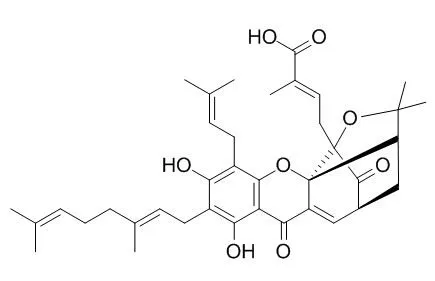| In vitro: |
| Sci Rep. 2015 Jan 9;5:7697. | | Isogambogenic acid induces apoptosis-independent autophagic cell death in human non-small-cell lung carcinoma cells.[Pubmed: 25571970] |
To overcome drug resistance caused by apoptosis deficiency in patients with non-small cell lung carcinoma (NSCLC), there is a need to identify other means of triggering apoptosis-independent cancer cell death. We are the first to report that Isogambogenic acid (iso-GNA) can induce apoptosis-independent autophagic cell death in human NSCLC cells.
METHODS AND RESULTS:
Several features of the iso-GNA-treated NSCLC cells indicated that iso-GNA induced autophagic cell death. First, there was no evidence of apoptosis or cleaved caspase 3 accumulation and activation. Second, iso-GNA treatment induced the formation of autophagic vacuoles, increased LC3 conversion, caused the appearance of autophagosomes and increased the expression of autophagy-related proteins. These findings provide evidence that iso-GNA induces autophagy in NSCLC cells. Third, iso-GNA-induced cell death was inhibited by autophagic inhibitors or by selective ablation of Atg7 and Beclin 1 genes. Furthermore, the mTOR inhibitor rapamycin increased iso-GNA-induced cell death by enhancing autophagy. Finally, a xenograft model provided additional evidence that iso-GNA exhibited anticancer effect through inducing autophagy-dependent cell death in NSCLC cells.
CONCLUSIONS:
Taken together, our results demonstrated that iso-GNA exhibited an anticancer effect by inducing autophagy-dependent cell death in NSCLC cells, which may be an effective chemotherapeutic agent that can be used against NSCLC in a clinical setting. | | J Chemother. 2013 Oct;25(5):298-308. | | Isogambogenic acid inhibits tumour angiogenesis by suppressing Rho GTPases and vascular endothelial growth factor receptor 2 signalling pathway.[Pubmed: 24070138] | Isogambogenic acid (iso-GNA) is a well-known herbal medicine extracted from Garcinia hanburyi.
This study carried out in vitro and in vivo evaluations of the anti-tumour and anti-angiogenic activity of Isogambogenic acid and underlying mechanisms.
METHODS AND RESULTS:
A standard methyl thiazolyl tetrazolium assay showed that Isogambogenic acid was more effective in inhibiting the proliferation of human umbilical vascular endothelial cells than A549 cancer cells. Isogambogenic acid demonstrated potent anti-angiogenic activity and low toxicity at appropriate concentrations in zebrafish embryos. In a xenograft nude mouse model of lung tumour, Isogambogenic acid effectively inhibited tumour growth and tumour angiogenesis. Isogambogenic acid suppressed neovascularization of implanted matrigel plugs in vivo and inhibited vascular endothelial growth factor (VEGF)-induced microvessel sprouting from mouse aortic rings ex vivo. Isogambogenic acid inhibited VEGF-induced migration, invasion, and tube formation in vitro and affected cytoskeletal rearrangement in human umbilical vascular endothelial cells. The results show that Isogambogenic acid suppressed angiogenesis-mediated tumour growth by targeting VEGFR2, Akt, mitogen-activated protein kinase, Rho GTPase, vascular endothelium-cadherin, and focal adhesion kinase signalling pathways.
CONCLUSIONS:
Together, these data suggest that Isogambogenic acid inhibits angiogenesis and may be a viable drug candidate in anti-angiogenesis and anti-cancer therapies. |
|






 Cell. 2018 Jan 11;172(1-2):249-261.e12. doi: 10.1016/j.cell.2017.12.019.IF=36.216(2019)
Cell. 2018 Jan 11;172(1-2):249-261.e12. doi: 10.1016/j.cell.2017.12.019.IF=36.216(2019) Cell Metab. 2020 Mar 3;31(3):534-548.e5. doi: 10.1016/j.cmet.2020.01.002.IF=22.415(2019)
Cell Metab. 2020 Mar 3;31(3):534-548.e5. doi: 10.1016/j.cmet.2020.01.002.IF=22.415(2019) Mol Cell. 2017 Nov 16;68(4):673-685.e6. doi: 10.1016/j.molcel.2017.10.022.IF=14.548(2019)
Mol Cell. 2017 Nov 16;68(4):673-685.e6. doi: 10.1016/j.molcel.2017.10.022.IF=14.548(2019)